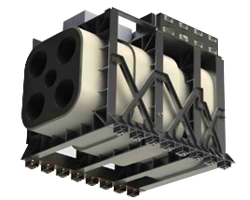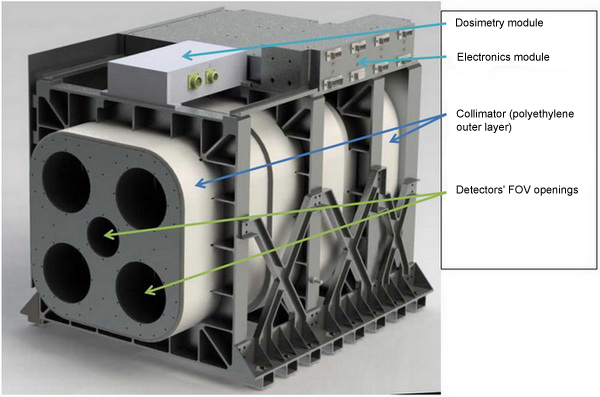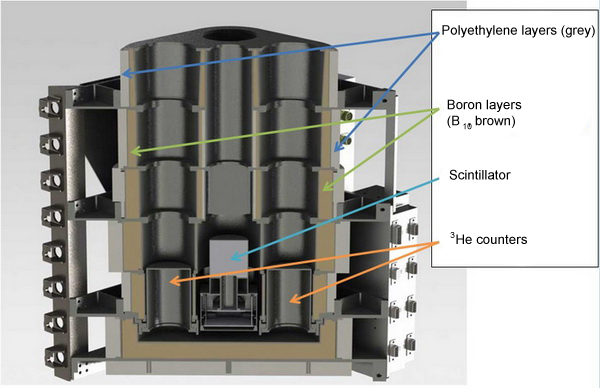FREND: Fine-Resolution Epithermal Neutron Detector for ExoMars Project
-------------------------------------------------------------------------------------------------------------------------------------------------
-------------------------------------------------------------------------------------------------------------------------------------------------

FREND (Fine-Resolution Epithermal Neutron Detector) for the ExoMars 2016 Trace Gas Orbiter spacecraft shall map neutron fluxes coming from Mars with high spatial resolution. Neutrons coming from the planet's surface are a good indicator of hydrogen abundance in the shallow layer (up to 1 m deep) of the regolith. Such maps are therefore of great importance for future Martian landing missions, since this information will help to choose landing sites more discriminatively.
FREND contains four 3He counters for neutrons with energies of 0.4 keV to 500 keV, and a stilbene-based scintillator for high-energy neutrons registration (up to 10 MeV). All of them have a narrow field of view (FOV) with the pixel size corresponding to 40 km on the Martian surface.
The instrument also includes a dosimetry module, which will constantly monitor radiation environment in orbit around the planet.
FREND is built within a joint Roscomos-ESA ExoMars project to be placed onboard the Trace Gas Orbiter spacecraft, due to be launched in 2016.
ExoMars is a joint Russian-European mission, which includes four spacecrafts, two of which were launched on March 16, 2016 and the other two will be launched in 2020 by the Proton launcher.
The first mission consists of the Trace Gas Orbiter (TGO) spacecraft, with European and Russian instruments on board, plus an Entry, Descent and Landing Demonstrator Module (EDM) built by ESA. TGO is still in orbit and will continue mapping the planet's surface for at least 2 earth’s years. EDM was supposed to perform demonstration of the landing and basic measurements of the Martian climate, but, unfortunately broke down (although managed to send quite a number of important information while descending).
The second mission, in 2020, will send to Mars a landing platform created by Roskosmos with a set of scientific equipment, and including a Rosalind Franklin Mars rover, created by ESA, containing Russian and European instruments. Both spacecrafts are designed for long-term work on the surface of Mars.
In 2001 a Russian instrument HEND (High Energy Neutron Detector) started operating onboard the Mars Odyssey mission (NASA). It bears similar set of detectors (namely, three 3He detectors ). After 13 years of operation, detailed maps of neutron fluxes were built, corresponding to hydrogen content in the surface's upper layer. HEND's detectors have an omnidirectional FOV, and therefore its spatial resolution is the distance 'from horizon to horizon', which in case of the Mars Odyssey's orbit is about 600 km. Such resolution is insufficient to study the hydrogen distribution in upper layers in details and it also hampers the choice of landing sites for new missions.
To narrow the neutron detector's FOV, it should be put inside a collimator, which can limit FOV to a small spot on the surface under the spacecraft. This collimator should be opaque for neutrons, coming outside the nadir.
Up until now a collimator of this kind, which narrows the neutron detector's FOV, has been used only once, in the LEND (Lunar Exploration Neutron Detector) instrument onboard the Lunar Reconnaissance Orbiter mission (NASA). The scheme has proved its efficiency. The LEND data was used to map neutron fluxes coming from the Moon with a spatial resolution of 5 km.
The FREND's design uses the legacy of its predecessors, HEND and LEND, and maximally exploits the technologies, which have already been tested and approved.
Main scientific goals of the FREND instrument are:
- to map epithermal and fast neutrons from the Martian surface with a spatial resolution of 40 km;
- to map hydrogen content in the upper layer (with the depth up to 1.5 m) of Martian regolith with the resolution of 40 km;
- to compare neutron fluxes from the Martian surface emitted during various seasons;
- to compare orbital data with those of similar missions, both orbital and Mars-based;
- to monitor neutron and charged particles fluxes during periods of high and low solar activity;
- to monitor radiation environment in orbit around Mars, which includes heliosphere regions at distances of 1 up to 1.5 AU from the Sun and in orbit around Mars, to study contributions of electrons, protons, and HZE-particles to the total radiation dose in the Martian orbit.
Mapping with high spatial resolution
To map the fluxes of neutrons (epithermal, thermal, and fast ones) and, thereafter, hydrogen distribution, FREND is equipped with a set of four 3detectors and one stilbene-based scintillation crystal.
3He detectors are proportional counters filled with helium under the pressure of 6 atmospheres and placed inside four openings of the collimator. Each of them counts neutrons independently, so that count statistics is higher (and, thus, maps are statistically more reliable) and the instrument is more resistant to failures.
These detectors measure neutrons with the energies of 0.4 to 500 keV. The scintillation counter, which uses a stilbene crystal, measures fast neutrons with the energies of 0.5–10 MeV. It is also placed inside the collimator. The scintillation module includes an anti-coincidence shielding, to discriminate between signals from high-energy charged particles and neutrons.
The FREND's collimation module is a passive element, encasing all five detectors. The collimator consists of two layers; the outer one is made of high-density polyethylene, the inner one - of enriched boron powder (B10). Neutrons, hitting the collimator's sides, are firstly slowed down by polyethylene, with large number of hydrogen atoms. So thermalized neutrons then pass through and get into B10 layer, which absorbs them.
The collimator's opening angle narrows FOV of the detectors to the spot with a diameter of 40 km on the Martian surface, when seen from the circular orbit with 400 km altitude, allocated for TGO. Thus, the spatial resolution of the neutron maps of Mars will be enhanced by 7.5 times compared to HEND maps.
Radiation control
The Liulin-MO dosimetry module measures the flux, the absorbed dose, and the dose intensity from the cosmic rays charged particles, as well as spectra of their ionization losses onboard the TGO. The ionization losses spectra are then converted into linear energy transfer (LET) spectra in human tissues, which is necessary for the estimation of the equivalent dose of cosmic radiation.
Main objectives of the dosimeter are:
- radiation probing of the Earth-Mars cruise trajectory, the orbit around Mars, and of the Martian surface, with respect to radiation safety for future spacecrafts;
- flight tests of the system to detect flux, dose, and cosmic radiation LET spectra. Similar systems then can be used in radiation control sets onboard future spacecrafts;
- further refining of our knowledge of radiation environment in the interplanetary space and on the surface of Mars, to estimate radiation exposure levels of a spacecraft and maintain radiation safety of the crew during manned interplanetary flights.
Liulin-MO measures the flux, absorbed dose, and dose intensity of cosmic charged particles, as well as ionization losses spectra and energy release spectra in the detectors of the instrument. The Liulin-MO's detection system consists of two telescopes with 2 semiconductor silicon detectors (effective area of 2 cm2) each. Dosimeter's energy resolution is not lower than 100 keV in the 100 keV÷8MeV energy release range (in a detector) and not lower than 350 keV in the 8÷70 MeV range.
Figure 1 gives a general view of the FREND instrument.

Fig.1. FREND. General view
The instrument consists of electronics and dosimetry modules located separately, in the upper part of the figure, a collimator module (several composite sections), which shields the detectors from the radiation coming outside the nadir direction, and five detectors (not seen in the figure).
The instrument is mounted via feet, as seen in the bottom part of the figure. On the opposite side of the instrument, there is a radiator, which maintains thermal regime for the instrument.
The instrument's profile and inner architecture of the collimator and detectors are presented in Figure 2.

Fig.2. FREND. Inner architecture
| Mass : | 36 kg |
| Power consumption : | 14 W |
| Dimensions : | 465 x 380 x 370 mm |
| Energy range : | 0.4–500 keV (neutrons) 0.5–10 MeV (charged particles) |
| Time resolution : | from 1 sec |
| Surface resolution : | ~60-200 km |
| Depth resolution : | ~1 m |
| Telemetry : | 50 Mbit per day |
The scientific phase of the TGO SC mission began in May 2018 and will last at least one Martian year, until May 2020. During this time, it is expected that the FREND instrument will compile a water distribution map in the near-surface soil at a depth of up to 1 m with a spatial resolution of up to 60 km in certain areas, and the dosimetry module will compile the radiation profile on the Mars orbit over the entire measurement period. At present, the measurements have just begun, but the results of the FREND and dosimeter measurements during the cruise phase have already been published.
Funding organization — Federal Space Agency of Russian Federation.
Primary contractor — Space Research Institute of the Russian Academy of Sciences (IKI RAS).
FREND’s Principal Investigator — Dr. Igor Mitrofanov.
Works on the FREND project are carried out under the State contract №025-5120/13/446 as of December 23, 2013 (R&D theme ExoMars-YaF).
Works on the FREND project are planned for 2012–2018 (development, tests, assembling, and instrument delivery) and 2018–2020 (operating and data processing).
| Space Research and Technology Institute of the Bulgarian Academy of Sciences (Sofia) |
Liulin-MO dosimetry module development. |
| Federal State Unitary Enterprise 'Fedorovsky All-Russia Science and Research Institute for Mineral Resources' of Ministry of Natural Resources and Environment of Russian Federation (VIMS, Moscow) |
Scintillator module development. |
| Joint Stock Company "State Scientific Center Research Institute of Atomic Reactors" (Dimitrovgrad-10, Ulyanovsk distr.) |
Enriched B10 recovery, filling the collimator with B10 powder. |
| A.A. Blagonravov Institute for Engineering Science of the Russian Academy of Sciences (IMASH, Moscow) |
Design verification and mechanical testing. |
| Joint Institute for Nuclear Research (Dubna, Moscow district) |
Physical calibrations and modelling. |
| Institute of Biomedical Problems of the Russian Academy of Sciences (IBMP) |
Dosimetry module development and testing support. |



